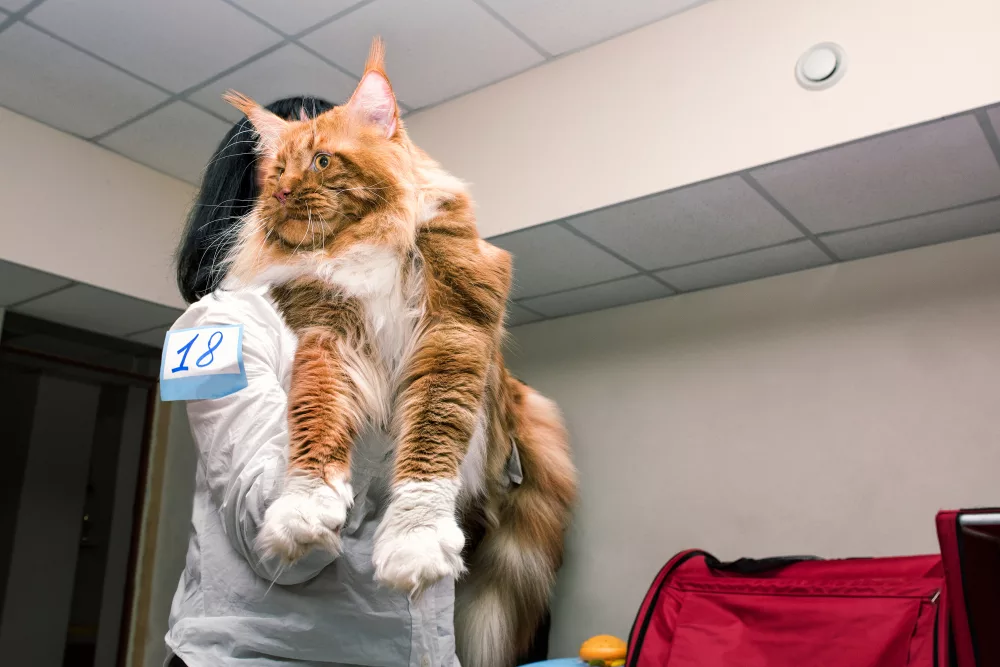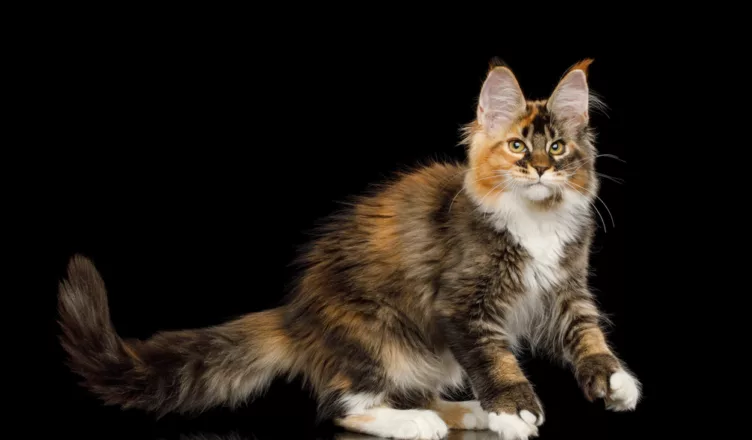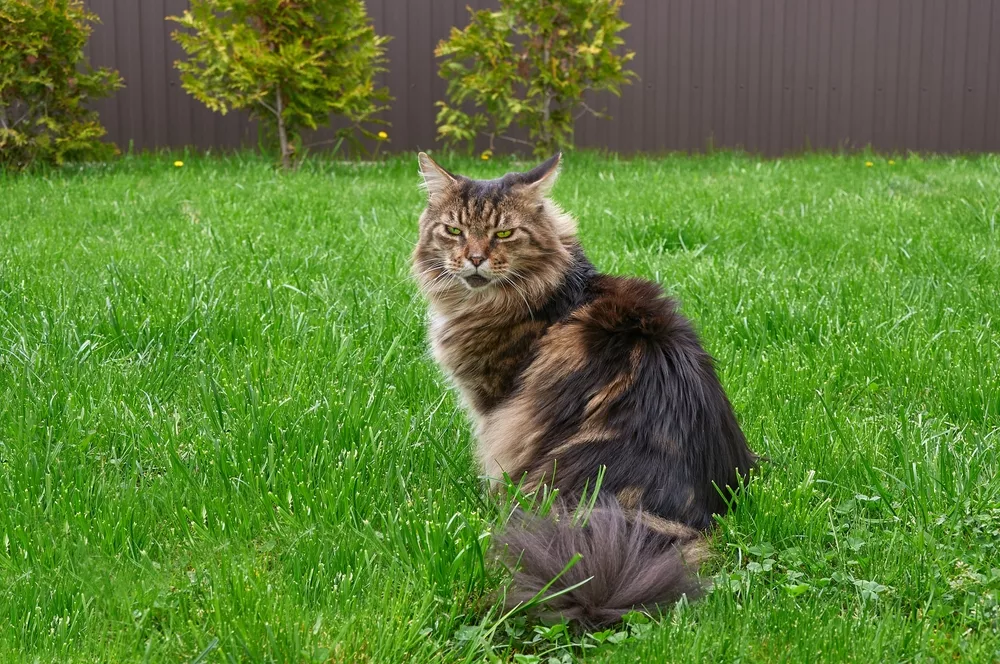The Maine Coon cat is a captivating and enchanting breed known for its large size, friendly personality, and striking appearance. Here, we will discuss the fascinating world of these gentle giants, providing a comprehensive overview of the history of Maine Coon cat and much more.
So, whether you’re considering adopting a Maine Coon or simply wish to learn more about these gentle giants of the cat world, read on to discover the unique traits that make them one of the most popular cat breeds.
Fascinating History of Maine Coon Cat
The history of the Maine Coon is filled with mystery and intrigue, as the exact origin of the cat breed remains uncertain. However, several theories attempt to explain the development of these captivating cats. Regardless of their beginnings, the Maine Coon has become one of the most popular and beloved cats breeds worldwide.
Theories on the Origin of the Breed
There are a few different theories surrounding the origin of the Maine Coon, but none have been definitively proven. Here are some of the most popular hypotheses:
|
Theory |
Description |
|
Seafarer’s Theory |
Believes that Maine Coons descended from cats brought to North America by English seafarers or Viking explorers. |
|
Marie Antoinette Theory |
Points that Maine Coons are descended from Turkish Angora or Persian cats sent to America by Marie Antoinette during the French Revolution. |
|
Native American Theory |
Suggests Maine Coons result from interbreeding between domestic cats and wild bobcats. |
|
Lynx Theory |
Proposes Maine Coons share a lineage with the North American Lynx based on physical similarities. However, genetic interbreeding between the two species is impossible. |
Descendants of Cats Brought by European Sailors
One theory suggests that Maine Coons are descendants of long-haired breeds brought to North America by European sailors in the 1700s. Cats were commonly kept on ships to control rodent populations, and it is believed that some of these long-haired cats, originating from countries such as France and England, were left in the New World. These European cats were then bred with local domestic cats, resulting in the distinct Maine Coon breed we know today.
Named After Captain Charles Coon
Captain Charles Coon was an English sea captain whose name has become intertwined with the history of the Maine Coon cat breed. According to popular lore, Captain Coon brought long-haired cats with him on his voyages to the northeastern United States, specifically the coast of Maine.
These cats are believed to disembark with the sailors and mate with the local domestic cats. Over time, their offspring developed the distinctive characteristics we now associate with the Maine Coon breed cat.
While there is no definitive proof to confirm the tale of Captain Charles Coon, this narrative has contributed to the mystique and allure of the Maine Coon’s origins. This charming story not only adds to the breed’s fascinating history but also highlights the possible role of seafaring and international trade in developing the Maine Coon’s unique traits.
Whether or not Captain Coon’s feline companions played a direct role in the breed’s history, this captivating tale will forever remain a part of the Maine Coon’s enduring legacy.
Descendants of Cats Brought by Vikings
Some people believe that Maine Coons are descendants of cats brought to North America by the Vikings around the year 1000. The Vikings were known to have kept cats on their ships for rodent control and companionship. The theory suggests that the Vikings’ cats interbred with native felines, leading to the development of the Maine Coon.
Queen Marie Antoinette Connection Theory
A more fanciful theory is that the ancestors of the Maine Coon cats were sent to America by Marie Antoinette, the last queen of France, as she attempted to flee France during the French Revolution. The theory claims that the queen’s favorite cats, which were long-haired and of Turkish Angora cats or Siberian descent, were sent to America in advance of her planned escape.
Captain Clough was hired to transport the Queen’s possessions over to America. In addition to her china, silver and furniture were loaded with six of the Queen’s longhaired cats. While Marie Antoinette never made it to America, her cats allegedly found their way to the northeastern United States, where they bred with local felines and contributed to the development of the Maine Coon.
While each of these theories offers a possible explanation for the origin of the Maine Coon breed, none have been definitively proven. The true ancestry of the Maine Coon remains a fascinating mystery that adds to the allure and charm of these captivating cats.
Crossbreeding of Domestic Cats with Raccoons
Another theory posits that Maine Coons developed from the crossbreeding of domestic cats with raccoons. Although this is genetically improbable, proponents of this theory point to the breed’s bushy tail, which resembles that of a raccoon, and the “Coon” in the breed’s name as evidence. This theory is primarily considered a fanciful myth rather than a plausible explanation for the breed’s origin.
The Lynx Theory
Among the varied theories that seek to explain the origin of the Maine Coon, one of the more captivating is the idea that these cats are related to lynxes. This theory, often called the Lynx Theory, is primarily based on the physical similarities between the Maine Coon and the North American lynx. Key features like the Maine Coon’s tufted ears and oversized paws, both traits shared with the lynx, have fueled this speculation.
The cat has tufted ears are particularly suggestive, as this characteristic is unusual among domestic cats but common in wild lynxes. Similarly, the large, well-furred paws of the Maine Coon help them move quickly through snowy terrain, much like the lynx. However, it’s crucial to note that while this theory is undoubtedly fascinating, it is highly improbable.
Domestic cats (Felis catus) and lynxes (genus Lynx) belong to different branches of the feline family tree and have other numbers of chromosomes, which makes interbreeding between the two species genetically impossible. Thus, while the Lynx Theory adds to the charm and mystery of the Maine Coon’s origins, it’s more likely that the shared traits result from adaptation to a similar environment rather than a shared lineage.
Maine Coons as Working Cats
Another critical aspect of the Maine Coon’s history is their use as working cats. Given the Maine Coon’s origins in the harsh climate, these cats developed traits that made them excellent hunters and mousers. Their size, agility, intelligence, water-resistant coats, and tufted paws made them well-suited to keeping barns and homes free from rodents.
This role as working cats contributed significantly to their early popularity, especially among farmers and sailors. Even as the breed has evolved and is now more commonly kept as a pet, the Maine Coon’s working cat roots still influence its personality and behavior. They are known for their playful and curious nature, often showing a keen interest in their surroundings and inclined to catch Maine Coon toys or other moving objects.
Development of the Breed in America
Regardless of their origins, the Maine Coon is native to the northeastern United States, particularly Maine, where it became the official state cat. Early settlers in the region valued the breed for its superior hunting skills, especially its ability to catch rodents in the harsh New England winters.
By the late 19th century, Maine Coons gained popularity as show cats and were recognized by cat fancier associations. Their popularity surged, and they became a subject of pride for America as a whole and the state of Maine in particular.
However, the Maine Coon breed’s popularity waned in the early 20th century as other long-haired breeds, such as Persians, gained favor. Fortunately, dedicated breeders and enthusiasts worked to revive interest in the Maine Coon, leading to a resurgence in popularity during the 1950s and 1960s.
Maine Coon is one of the most sought-after cat breeds in the United States and around the world today. Their striking appearance, friendly Maine Coon personality, gentle disposition, and fascinating history continue to captivate cat lovers, making them a sought-after breed for companionship and show purposes.
Role of Natural Selection in the Development of Maine Coon Breed
Natural selection played a significant role in shaping the Maine Coon’s unique characteristics. Living in the harsh environment of the northeastern United States, particularly in Maine, these cats had to adapt to survive the challenging conditions. The large Maine Coon size, sturdy build, and thick double coat are all adaptations that allow the breed to withstand cold temperatures and snowy, harsh winters.
The Maine Coon’s excellent hunting skills also contributed to its survival and success. Known for their prowess in catching rodents and other small prey, these cats were highly valued by early settlers who relied on them to protect their food stores and homes from vermin infestations. As a result, natural selection favored those cats that were better suited to the region’s climate and demonstrated superior hunting abilities.
Maine Coon Influence on Other Breeds
The Maine Coon’s unique characteristics and popularity have not only contributed to its own success but also influenced the development of other cat breeds. Some cat breeds, such as the Siberian cat and the Norwegian Forest Cat, share physical traits with the Maine Coon, such as their large Maine Coon size, tufted ears, and long, bushy tails.
These similarities have led to speculation about possible genetic connections between the main coon cat and breeds. Additionally, the Maine Coon’s popularity has inspired breeders to create hybrid breeds that combine the traits of the Maine Coon with those of other famous breeds.
One such example is the Maine Coon Ragdoll mix. This fascinating fusion brings together the regal allure of the Maine Coon and the gentle, tender-hearted nature of the Ragdoll.
Preservation and Promotion of the Breed
As the Maine Coon’s popularity grew, enthusiasts and breeders worked to preserve the breed’s unique characteristics and promote its continued development. In 1953, the Central Maine Cat Club (CMCC) was formed to showcase and celebrate Maine Coons. They organized the first Maine Coon-only cat show in 1968, which helped propel the breed into the spotlight.
In 1967, the Maine Coon Breeders and Fanciers Association (MCBFA) was established to provide breeders with a support network, share information, and develop breeding standards. The MCBFA played a crucial role in preserving and promoting the breed, leading to its recognition by significant cat registries, including the Cat Fanciers’ Association (CFA) and The International Cat Association (TICA).
Maine Coon Breed Clubs and Organizations
Today, there are numerous breed clubs and organizations dedicated to the Maine Coon, both in the United States and around the world. These clubs work to educate the public about the breed, support responsible breeding practices, and organize events and shows for enthusiasts to showcase their cats.
The continued popularity and interest in the Maine Coon cat ensures a dedicated community of breeders, cat fanciers association, and enthusiasts working together to celebrate, preserve, and promote these captivating cats. As a result, the Maine Coon’s legacy will continue to thrive and enchant cat lovers for generations to come.
Role of Maine Coons in Cat Shows and Competitions

Maine Coons have been participating in cat shows since the late 19th century. In 1895, a Maine Coon named Cosey won Best Cat at the first-ever cat show held at Madison Square Garden in New York City. Since then, the breed has continued to excel in cat show competitions, earning numerous titles and awards at both national and international levels.
Maine Coons participate in various categories within cat shows, such as conformation judging, where cats are judged based on how closely they adhere to breed standards. Additionally, some shows and competitions highlight the breed’s agility, intelligence, and trainability, with categories focusing on obedience, tricks, and obstacle courses.
The breed’s success in cat shows has not only increased its popularity among cat lovers but also helped refine and preserve breed standards. As breeders work to produce cats that meet and exceed these standards, the Maine Coon continues to evolve and improve, further solidifying its status as a beloved and respected breed.
In addition to their success in the show ring, Maine Coons have also found fame in popular culture. They have appeared in movies, television shows, and even commercials, further cementing their status as a beloved breed.
Celebrating the History of Maine Coon Cats
The Maine Coon’s captivating history is a blend of intriguing theories and enduring charm. The breed’s mysterious origins are intertwined with tales of European sailors, Viking explorers, and even French royalty. These majestic felines have adapted to the harsh conditions of the northeastern United States, developing into a distinct and beloved breed.
Despite the unanswered questions surrounding their beginnings, these majestic cats have captured the hearts of cat enthusiasts worldwide, leaving a lasting legacy that continues to enchant and inspire. Maine Coons tend to be patient with children, household pets, other cats, and dogs. As we celebrate the enchanting legacy of Maine Coon cats, we appreciate their rich history and contributions to the world of feline companionship.
FAQs
What is the history of a Maine Coon cat?
The Maine Coon is a native North American breed believed to have originated in Maine, USA. They’re known for their hunting skills and adaptability, with a history shrouded in fascinating theories and folklore.
Where did Maine Coons originally come from?
Maine Coons are indigenous to the United States, specifically the state of Maine, hence their name. They’re believed to have descended from cats brought to North America by early settlers or seafarers.
What 2 breeds make a Maine Coon?
The Maine Coon is not a crossbreed but a naturally occurring breed. Its precise ancestry is unknown, although several theories exist, including influence from overseas long-haired breeds.
What breed is the original Maine Coon cat?
The original Maine Coon cat is a naturally occurring breed believed to have descended from domestic cats in the northeastern US, possibly mixed with long-haired breeds brought by sailors.


